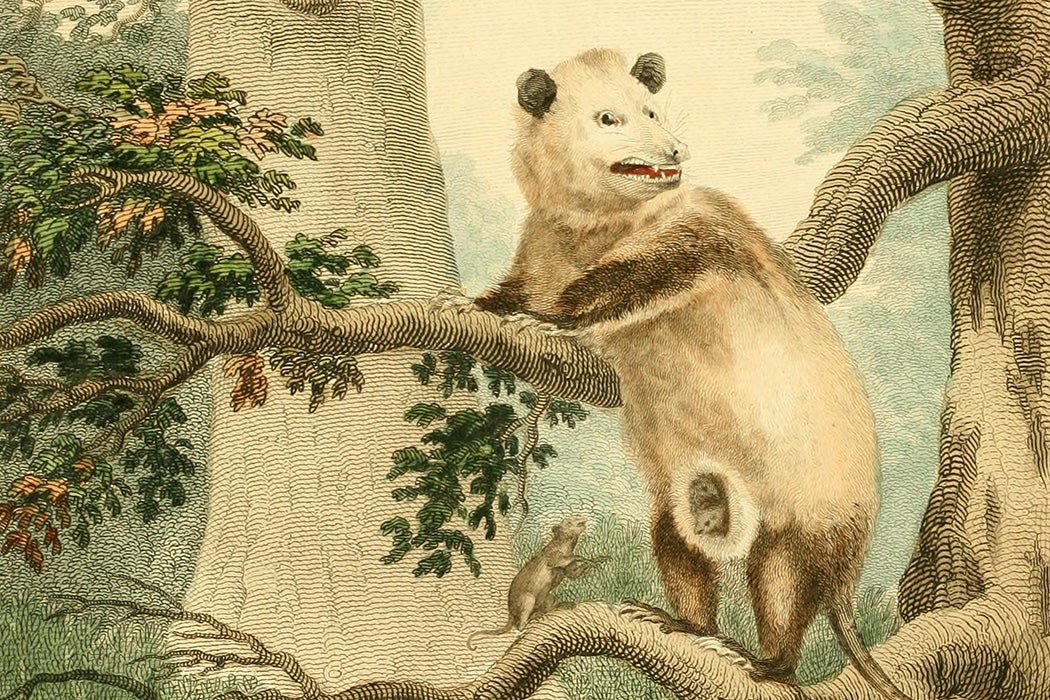Marsupials are so associated with Australia that it may surprise you to discover that the first marsupial known to European science actually came from North America. There are more than a hundred species of marsupial in South America, but it was the lone marsupial species found north of Mexico that first freaked out Europeans. The Virginia opossum, Didelphis virginiana, with its marsupium, or pouch or purse for the continued development of embryos, initially came across as a monstrous chimera.
Between the trees he saw as strange a Monster, the foremost part resembling a Fox, the hinder a Monkey, the feet were like a Mans, with ears like an Owl; under whose Belly hung a great Bag, in which it carry’d the Young, which they drop not, nor forsake till they can feed themselves.
This is Vincent Yáñex Pinzón’s 1499 description, as translated in John Ogilby’s America of 1671.
“Initial accounts of the opossum described the female as a composite fitted with a strange anatomic part,” writes scholar Susan Scott Parrish, placing these first reports in the tradition of female monsters that stretches back to “biblical allegories of corrupt nations and cities.” As it turned out, the opossum’s differences—among other things, the genus name Didelphis means two uteruses—could be enlisted in successive constructions of the New World: as monstrous, degenerate, or blessed.
In fact, as Parrish details, the female of the species was soon enough transformed into a positive model of fecundity and motherhood, “proof of nature’s maternal providences.” After all, she carried all those motivated little embryos—who blindly crawl into her pouch after birth—until they could stand, or hang on their prehensile tails, alone.
Even though opossums were often described as “foetid stinking Animal[s],” female opossums nonetheless came to symbolize the wonderful richness of life in the Americas. And then she was enlisted in eighteenth-century “scientific theories of female anatomy and generation [that] helped to naturalize women as domestic caretakers.” The social/economic/political “privatization” of women during this period was “rendered natural by discoveries made in the laboratory and in the wild.”
The female opossum became exemplary in this scientific rendering of womanhood, writes Parrish. What more scientific proof of women’s place in society was needed? The opossum was considered so “well-suited to human investigation”—that is, the embryos could be seen with the naked eye, a human hand could easily slip into the pouch—that it was as if “maternal nature created this particular animal as the source of revelation about her own powers of generation.” [italics in original] From Nature as a female force to the natural ordering of females, marsupial or human, as maternal.
Around the time of the War of 1812, American naturalist Benjamin Smith Barton awkwardly explained evidence of female opossum cannibalism by suggesting that by eating her young, she was doing a service to farmers by keeping the possum population in check. Parrish paraphrases this archly: “Apparently, she was such a pure distillate of human motherhood that she cared more for human welfare than for her own nonhuman children.”
As it happens, your average settler-colonists were not as enamored of the opossum as the savants were. They took the Powhatan word for the animal, rendering it in a variety of ways: possum, opposum, aposon, oppasom, aposoum, etc. The original is usually translated as “white dog.” Whatever it was called, the omnivorous animals were often considered pests, and in some quarters they still are.
Weekly Newsletter
When threatened, opossums essentially faint and exude foul odors, as if they were dead and rotten. “Playing possum,” meaning to pretend to be asleep or dead, thus became a synonym for faking it—often in a life-saving way.
More recently, opossums were much touted as voracious tick-eaters, but this lab finding suggests that it’s not replicated in the wild.
It’s as if animals need superpowers, or super symbolism, to get any respect around here.







